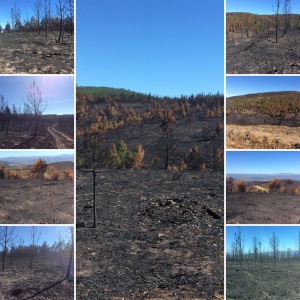Adrián Regos and colleagues highlight how their conservation planning objectives can lead to ‘win-win’ situations for bird conservation and wildfire prevention in fire-prone abandoned landscapes. This follows the recent publication of their article, Trade‐offs and synergies between bird conservation and wildfire suppression in the face of global change.
Protected areas play a key role in safeguarding biodiversity worldwide. However, their role can be seriously compromised in highly dynamic socio-ecological systems as traditional conservation approaches, which are generally based on selecting static protected areas, struggle to cope with global change and its multiple effects on biodiversity. In Europe, the Natura 2000 (N2000) network is a network of protected areas that constitutes the backbone of biodiversity conservation. In December 2016, the European Commission published its “Fitness Check” evaluation of the EU Nature Directives and concluded that, within the framework of broader EU biodiversity policy, they remain highly relevant and are fit for purpose. However, ‘…fully achieving their objectives and realising their full potential will depend on substantial improvement in their implementation in relation to both effectiveness and efficiency …’.
In our recently published study, we predicted the future effectiveness of the N2000 network at maintaining and representing suitable environmental conditions for a set of 79 bird species between 2000 and 2050 in a fire-prone area, strongly affected by land abandonment processes in north east Spain. We then compared the performance of the N2000 network with a set of alternative priority areas for conservation, which consider fire-vegetation dynamics, selected by using a conservation planning tool (MARXAN). Fire-vegetation dynamics were modelled using a process-based model (MEDFIRE MODEL) under alternative fire management and climate change scenarios. Bird communities were predicted using the spatially explicit species assemblage modelling framework (SESAM) and species distribution models that integrate climate change and wildfire-vegetation dynamics.

Our simulations predicted that exclusively changing fire management from the business-as-usual scenario (high levels of fire suppression, involving a large amount of resources invested annually in firefighting) to a strategy based on letting unplanned fire burns under controlled fire-weather conditions (a more cost-effective option) would result in a strong increase in the effectiveness of the current N2000 for open-habitat species such as Dartford warbler (from −50% up to 5%). However, the conservation of suitable conditions for other early successional species within the protected areas, such as Ortolan bunting, was predicted possible only under fire management policies that aim to create new open spaces. This scenario would also need more adaptive planning, wherein new priority conservation areas would substantially complement the current N2000 network.

Moreover, land abandonment has been proposed as an opportunity for conservation in Europe (cf. ‘ecological rewilding’ concept), mainly for forest biodiversity. Our study also shows that the availability of suitable environmental conditions for some forest species within protected areas will likely increase in the future. However, other forest-related species may suffer a strong decline in environmental suitability due to climate change according to our simulations (e.g., Black woodpecker). Forest biomass extraction for bioenergy uses could play an important role in the conservation of these forest-specialist species in the near future, while reducing fuel accumulation and fire risk. The decision will therefore depend on the specific conservation and fire prevention objectives that managers could have within N2000: a trade-off between reducing fire impacts with side effects on early successional species or ensuring the protection of forest species at the cost of a higher fire risk. Given the context of long-standing land abandonment, early successional species would strongly benefit from fire management strategies alternative to those implemented nowadays, with co-benefits for fire prevention and low side effects on forest species, that is, a win-win situation.
Our results also highlight the increasing role of protected areas in the representativeness of bird species in the future. Fire management is expected to play a key role in this regard, as higher representativeness values will likely be achieved under the business-as-usual scenario (i.e., high levels of fire suppression) in an adaptive PA system or under an alternative fire management strategy based on forest biomass extraction under the current N2000 system. Again, the decision will depend on the specific conservation and fire prevention objectives; a balance between maintaining the current fire suppression policy and increasing the protected-area system or promoting renewable energy-based forest management within the current N2000 network.
Read the full article, Trade‐offs and synergies between bird conservation and wildfire suppression in the face of global change, in Journal of Applied Ecology.
This post is available in Spanish here.

One thought on “Integrating fire management policies within conservation planning: ‘win-win’ solutions for bird conservation and wildfire prevention”